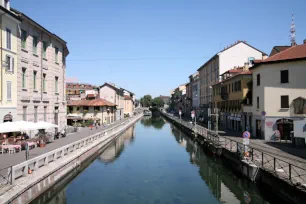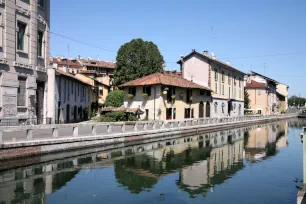Navigli is one of the most romantic neighborhoods in Milan. Situated southwest of the city’s historic center, the neighborhood is named for the navigli, canals that were once ubiquitous in this former port area.


In its heyday, the canals formed a 150 km long network that connected the city with the rivers and lakes in the Lombardian region. The canals were used for irrigation; they provided the city with water and were ideal to transport people (it was much safer than traveling on roads) and goods to and from remote areas as far as the Alps and even the sea, reached via the river Po. The marble used for the construction of the Duomo was transported via these waterways from the Lago Maggiore near the Alps to the center of the city.
History
Construction of the oldest canal, the Ticinello, started in 1179, quickly succeeded by a number of other canals. A series of locks were built to overcome the differences in elevation which at the time posed a serious technical challenge. It is said that Ludovico di Moro, duke of Milan at the end of the fifteenth century, requested the help of Leonardo da Vinci to design an innovative system of sluices.
Thanks to this network of canals, Milan had one of the country’s largest inland ports, despite the absence of a main river. The canals were so much part of the urban fabric that some areas of the city resembled Venetian neighborhoods. With the growing importance of road transportation, traffic on the canals dwindled quickly and many were filled in – often for sanitary reasons – during late nineteenth and early twentieth century until the activity came to a complete standstill in 1979.

Navigli Today
Only three canals survived to this day: the Naviglio della Martesana in the north-east and the Naviglio Grande and Naviglio Pavese in the southwest of the city. The latter two form the backbone of the neighborhood that is now known as Navigli. They join at the Darsena, a 750-meter-long (2460 ft) bassin that formed the heart of the old port.
Present day Darsena is a rather desolate sight situated near one of Milan’s least attractive squares – the Piazza XXIV Maggio – and is of little interest but follow one of the canals, and you’ll soon discover some of the charm that still lives on in this part of the city.
While it was long an impoverished working-class neighborhood and still looks a bit rough, things have changed for the better since the 1980s, when houses along the canals were renovated, artists started moving in to find inspiration in the idyllic quarter, and restaurants opened along the waterways. Today there are plenty of bars and restaurants in the area – some in disused barges – and several antique and design stores have opened here.
Naviglio Grande

The most interesting of the few remaining canals is the Naviglio Grande. Here you’ll find iron pedestrian bridges, a small church – the Santa Maria delle Grazie al Naviglio – and the picturesque Vicolo dei Lavandai. Here, women washed their family’s clothes with water from the canal.
The mostly pedestrian-friendly streets along the canal were once tow-paths, from which horses and oxen towed the barges. The Naviglio Grande is best visited during summer months, when you’ll often see cruise boats on the canal. It’s especially worth a visit every last Sunday of the month, when the ripa di Porta Ticinese – on the south side of the Naviglio Grande – is the site of an antique market.

